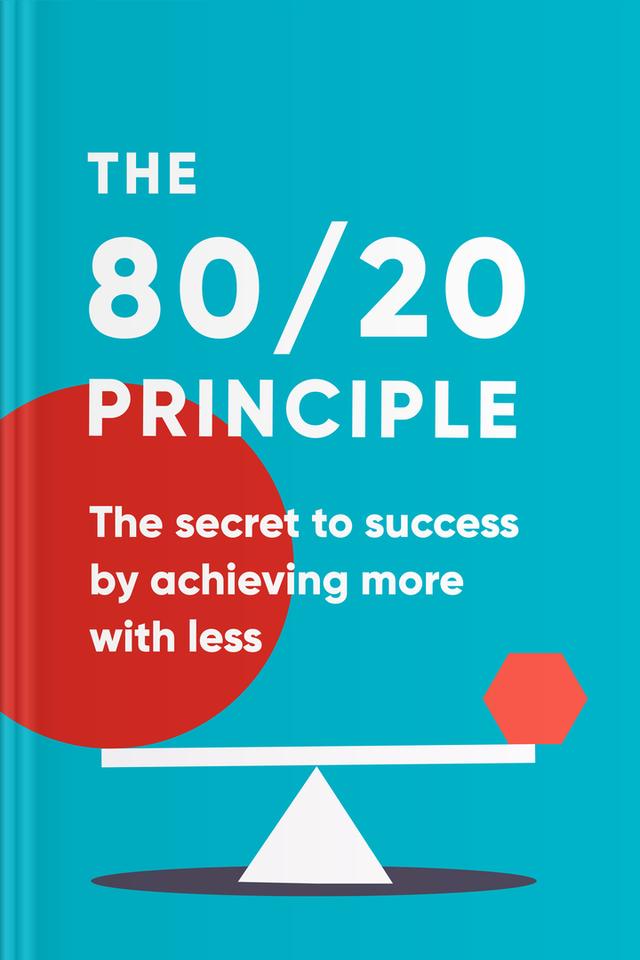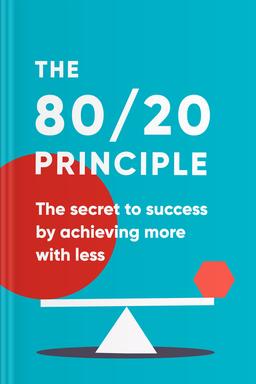You’ll learn
- Why doing less can give you more
- How and where the 80/20 rule can be implied
- About why it’s not always the 80/20 ratio
- The art of focusing on what matters
- Effective business lessons
russia has launched a full-scale war in Ukraine. Donate to support Ukraine and protect the world’s peace.

first KEY POINT
What if 80% of your stress comes from just 20% of your daily decisions? What if you could double your results by eliminating four out of five things you currently do?The surprising truth is that a small minority of your efforts creates the vast majority of your results. This is the 80/20 principle – and it's about to change how you approach everything.The principle works like this: Roughly 20% of actions produce 80% of effects. So, in your career, 20% of your tasks generate 80% of your value. In relationships, 20% of your connections provide 80% of your support. In learning, 20% of concepts deliver 80% of understanding. The exact numbers vary, but the imbalance is consistent and powerful.The 80/20 principle uniquely cuts across all segments of society. Some refer to it as the Pareto principle, as Vilfredo Pareto was the one who described it first.As an economist, Pareto's career involved studying the economics of nations and how resources were distributed among people. It was while doing this that he discovered a repeating pattern. He found that the wealth of every nation was controlled by just a few minorities. This discovery led him to study the concept further, realizing how consistent the principle was.Individuals who understand the 80/20 concept have been using it to maximize personal and corporate productivity. Now it’s your turn.
However, the 80/20 principle doesn't necessarily imply that precisely 80% of results come from 20% of actions. The percentages are not always consistent. What's consistent is that a few steps are essential in the whole scheme of things. Understanding this will help you prioritize the things that matter. For example, what should a company do when a fifth of its customers make the most purchases? A reasonable approach is to find creative ways to satisfy that 20%. Perhaps they could create a loyalty program with early access to new products, or assign their best customer service rep to handle their inquiries. They could also develop new strategies to market to the bottom 80% — perhaps these customers need different pricing, simpler products, or more education about their services. But they won't know how to do this effectively if they don't take the time to see how the 80/20 phenomenon applies to their organization.Soon, you'll learn how the 80/20 principle can help you in the corporate world and your personal life. Let's get started!
second KEY POINT
Every business venture is out to maximize profit. It's sad that, at one point or another, most businesses will experience setbacks that could have been avoided if the decision-makers knew better.What if the 80/20 principle can help you pinpoint potential loopholes in your business?Many businesses use the 80/20 principle to their advantage with the resources at hand. You, too, can apply the principle to your business. It's not difficult, but a bit analytical. Here's a simplified way to go about it: Take the time (or hire an analyst, if you can) to study the following three components of your business: your products, your customers, and your market position.How many products or product lines do you produce in a month, six months, or a year (choose the most reliable stats), and what are the sales and profits for these products?You will understand what customers use your services the most and how often, as well as those that don’t contribute significantly to your sales. You will likely find an imbalance — only a few percent of your total customers contribute to the bulk of your business profit.Go deeper to understand the reason for the trend. Ask specific questions: Do your high-value clients share common industries, company sizes, or needs? What specific features or services do they value most? What initial problems brought them to you? Document these patterns to replicate your success.

Continue reading with Headway app
Continue readingfirst KEY POINT
second KEY POINT
third KEY POINT
fourth KEY POINT
fifth KEY POINT